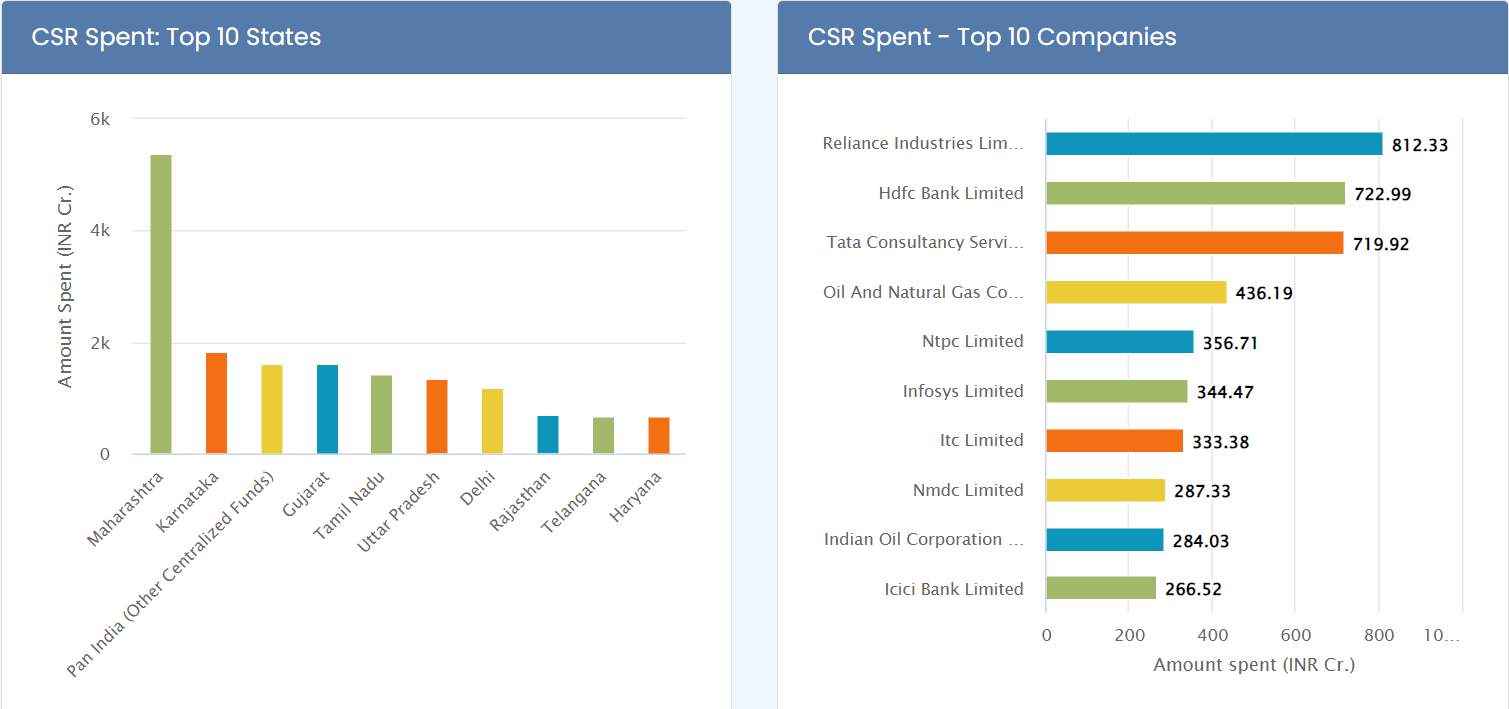- Courses
- GS Full Course 1 Year
- GS Full Course 2 Year
- GS Full Course 3 Year
- GS Full Course Till Selection
- Answer Alpha: Mains 2025 Mentorship
- MEP (Mains Enrichment Programme) Data, Facts
- Essay Target – 150+ Marks
- Online Program
- GS Recorded Course
- Polity
- Geography
- Economy
- Ancient, Medieval and Art & Culture AMAC
- Modern India, Post Independence & World History
- Environment
- Governance
- Science & Technology
- International Relations and Internal Security
- Disaster Management
- Ethics
- NCERT Current Affairs
- Indian Society and Social Issue
- NCERT- Science and Technology
- NCERT - Geography
- NCERT - Ancient History
- NCERT- World History
- NCERT Modern History
- CSAT
- 5 LAYERED ARJUNA Mentorship
- Public Administration Optional
- ABOUT US
- OUR TOPPERS
- TEST SERIES
- FREE STUDY MATERIAL
- VIDEOS
- CONTACT US
Education Receives Highest Share of CSR Funds in India
Education Receives Highest Share of CSR Funds in India
18-09-2024
- In August, 2024, the government data revealed that the highest share of corporate social responsibility (CSR) spending in FY23 went to education, with Rs 10,085 crore allocated.
- This sparked discussions about the unequal distribution of CSR funds across certain sectors and regions.
- The number of CSR projects also rose from 44,425 in FY22 to 51,966 in FY23.
- Private sector companies contributed 84% of the total CSR spending.
Sector-wise Expenditure
- Education: Received the largest portion, accounting for 1/3rd of the total CSR expenditure in FY23, with Rs 10,085 crore allocated.
- Vocational Skills: Spending increased to Rs 1,164 crore in FY23 from Rs 1,033 crore in FY22.
- Technology Incubators: Saw the lowest allocation, receiving only Rs 1 crore in FY23, a drop from Rs 8.6 crore in the previous year.
- Health, Rural Development, Environmental Sustainability, and Livelihood Enhancement: These sectors also received notable CSR contributions.
- Animal Welfare: Funding increased significantly, increasing from Rs 17 crore in FY15 to over Rs 315 crore in FY23.
- Prime Minister Relief Fund: CSR spending decreased to Rs 815 crore in FY23, down from Rs 1,215 crore in FY22 and Rs 1,700 crore in FY21.
- Disaster Management and Slum Development: Contributions dropped sharply, with disaster management seeing a 77% decline, and slum development expenditure falling by 75%.
Region-wise Expenditure:
- The states of Maharashtra, Karnataka, and Gujarat received the highest share of CSR spending.
- In contrast, the North Eastern states, along with Lakshadweep and Leh and Ladakh, received the least CSR funding.

What is CSR?
- Corporate Social Responsibility (CSR) refers to a company’s initiative to evaluate and address its environmental and social impacts.
- CSR is a self-regulating business approach that ensures companies are mindful of their contributions to the economy, society, and environment.
- By adopting CSR practices, businesses can be aware of their influence on these aspects.
- India became the 1st nation to enforce mandatory CSR spending through Section 135 of the Companies Act, 2013. This legal framework outlines potential CSR activities that companies must undertake.
- In contrast, many other countries have voluntary CSR models and some countries like Norway and Sweden have gradually moved to mandatory provisions after starting with voluntary efforts.
Applicability
- CSR provisions apply to companies that meet any of the following conditions during the previous financial year:
- Net worth exceeding ₹500 crore
- Turnover greater than ₹1000 crore
- Net profit over ₹5 crore
- Such companies are required to allocate at least 2% of their average net profits over the last three years to CSR initiatives.
- Newly incorporated companies base their CSR spending on profits from preceding financial years.
Types of Corporate Social Initiatives
- Corporate Philanthropy: Charitable donations through a corporate foundation.
- Community Volunteering: Organised volunteer efforts led by the company.
- Socially Responsible Business Practices: Producing and promoting ethical products.
- Cause Promotions and Activism: Company-sponsored advocacy and awareness campaigns.
- Cause-Based Marketing: Donations tied to product sales.
- Corporate Social Marketing: Campaigns funded by the company to promote positive behavioural changes.
Eligible Sectors
CSR activities can cover various sectors, including:
- Addressing hunger and poverty
- Promoting education and gender equality
- Combating diseases like HIV/AIDS
- Ensuring environmental sustainability
- Supporting government relief efforts (such as PM CARES and PM Relief Fund)
- Contributing to socio-economic development and the welfare of disadvantaged groups
Challenges in CSR Compliance
- Geographic Imbalance in CSR Spending: CSR investments are largely concentrated in industrialized states like Maharashtra, Gujarat, Karnataka, and Tamil Nadu.
- In contrast, regions such as the North Eastern states, Lakshadweep, Leh, and Ladakh receive significantly less, indicating a regional disparity.
- CSR Allocation Patterns: According to Ministry of Corporate Affairs data, approx. 75% of CSR funds are directed towards three main areas: education, healthcare (inc. water and sanitation), and poverty alleviation in rural areas.
- Minimal investment is directed towards sectors like livelihood enhancement.
- Public vs. Private Sector CSR Spending: Non-public sector units (non-PSUs) contribute 84% of total CSR spending, while PSUs contribute the remaining 16%, showing a marked difference in spending between these sectors.
- Misalignment of CSR Strategy: Many companies integrate CSR into their business strategies with a focus on profit, which dilutes the social impact and defeats the actual purpose of CSR.
- Difficulty in Partner Selection: Even with growing awareness about CSR, companies often struggle to find suitable partners and projects that are long-lasting, scalable, and self-sustaining.
- Transparency Issues: Companies often express concerns about the lack of transparency from local implementing agencies, particularly in areas such as information disclosure, audits, impact assessments, and fund utilization.
How Can CSR Expenditure be Made More Effective?
- Strengthening CSR Engagement and Oversight: CSR efforts can be aligned with local government initiatives such as the Aspirational Districts Programme (ADP) to encourage community participation.
- Governments should ensure proper implementation and use AI tools for better monitoring.
- NGOs can collaborate with companies to ensure successful CSR implementation in rural and remote areas.
- Addressing Sectoral and Regional Disparities: There is a need to invest in higher education, technological innovation, and environmentally sustainable projects that focus on skill development and enhancing livelihoods.
- CSR programs should target underfunded regions. Companies could be incentivized to invest in these areas or mandated to address regional disparities. Partnerships with local NGOs can also help bridge these gaps.
- Balancing PSU and Non-PSU CSR Spending: PSUs should be encouraged to increase their contributions and adopt best practices through benchmarking.
- Joint CSR initiatives between PSUs and non-PSUs can also help balance spending.
- Enhancing Governance and Corporate Roles: Companies should conduct regular CSR reviews, set clear objectives, and strengthen governance roles.
- New standard operating procedures (SOPs) should be developed for fund utilization, impact assessments, and detailed checklists.
Conclusion
For CSR to create meaningful impact, companies must go beyond compliance and strategically align their efforts with local government programs. Addressing sectoral and regional disparities, ensuring transparency, and fostering collaboration between PSUs and non-PSUs are key steps to drive sustainable social change and contribute to India's long-term development.
Must Check: Best IAS Coaching In Delhi
UPSC Prelims Result 2024 Out: Expected Cut Off & Other Details, UPSC Prelims 2024 Answer with Explanation, Daily Prelims Quiz, Daily Current Affairs, MONTHLY CURRENT AFFAIRS TOTAL (CAT) MAGAZINE, Best IAS Coaching Institute in Karol Bagh, Best IAS Coaching Institute in Delhi, Daily Mains Question Answer Practice, ENSURE IAS UPSC Toppers, UPSC Toppers Marksheet, Previous Year Interview Questions, UPSC Syllabus




